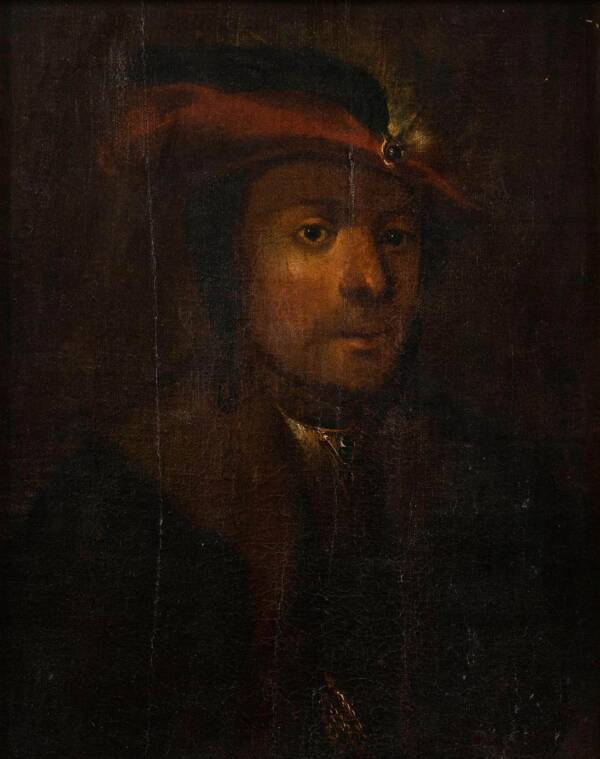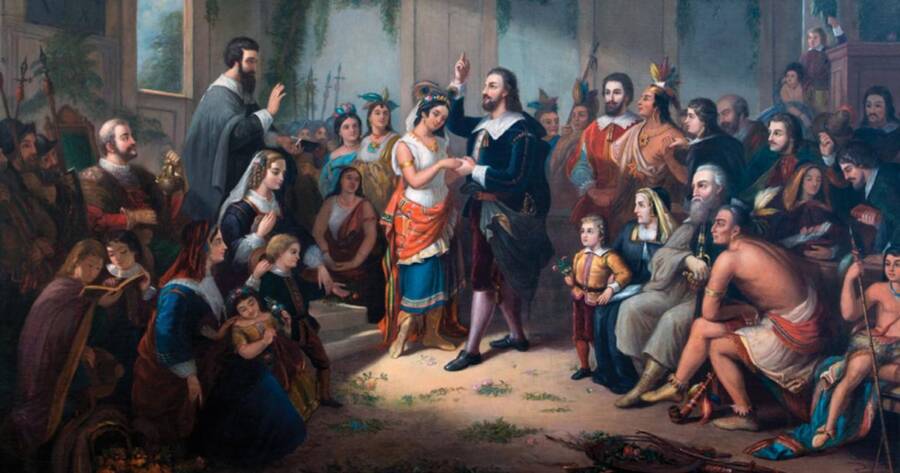Thomas Rolfe was born in the New World in 1615 to Pocahontas and John Rolfe, and while much of his life is left to speculation, historic records and Native American oral traditions paint a conflicting picture of him.

Public DomainA 17th-century painting of a young man who may be Thomas Rolfe.
When Pocahontas, the daughter of a powerful Powhatan chief, converted to Christianity and married Englishman John Rolfe, their union and the birth of their son Thomas Rolfe appeared to have helped create a brief period of peace in colonial Virginia, forging new ties between the English settlers and the Powhatan people.
These ties, however, were fragile, and Thomas Rolfe himself would spend much of his life as a man torn between two worlds.
Although he was born in Virginia, Rolfe spent the better part of his youth in England. And though he attempted to reconnect with his Powhatan family members after he returned to America as an adult, it appears that he ultimately aligned himself more with his English heritage — and even fought against the Native Americans as a lieutenant in the English military.
This is the story of Pocahontas’ mysterious son and his complicated legacy.
The History-Defining Union Of Pocahontas And John Rolfe
Thomas Rolfe’s story begins with the unlikely relationship between his parents: Powhatan Pocahontas and Englishman John Rolfe.
Pocahontas first gained a reputation among the English settlers as a peacemaker after, according to Captain John Smith’s own account, she purportedly saved Smith from execution at the hands of the Powhatan people around 1607.
By 1614, Pocahontas had converted to Christianity and gotten baptized. Her new status as a Christian allowed her to marry the English planter John Rolfe in April of the same year.
This union helped establish a brief period of peace between the English settlers and the Powhatan people. The birth of Thomas Rolfe in 1615, it seemed, only continued to strengthen it.
But some evidence suggests that Thomas Rolfe’s birth may not have been not a sign of flourishing peace between two peoples, but a product of the violence the English settlers inflicted on the Native Americans.
The Conflicting Stories Of Thomas Rolfe’s Birth

Library of CongressThe Marriage of Pocahontas by Henry Brueckner, c. 1855.
While modern history records state that Thomas Rolfe was the son of Pocahontas and John Rolfe, other sources point to a much grimmer possibility.
According to American Indian Magazine, Pocahontas had married her first husband Kocoum, a Powhatan warrior, when she was 15 or 16 years old.
Then, an English traveler named Captain Samuel Argall arrived in Virginia and, hoping to hold Pocahontas captive to extract ransom from her family, tricked her into boarding his ship, and kidnapped her. Around this time, it’s believed the Englishmen may have murdered Kocoum.
While in captivity, Pocahontas fell into a depression so deep that Captain Argall, worried she would not survive, decided to send for her sister, Mattachanna.
According to the 2007 book The True Story of Pocahontas, The Other Side of History, which is largely based on Powhatan oral history, Pocahontas confided in her sister that she had been raped and feared that she was pregnant.
Oral tradition suggests that Thomas Rolfe was in fact born prior to the marriage ceremony between Pocahontas and John Rolfe. This may explain why John, the colony’s recorder of births, did not document the birthdate of his “son,” as Christian custom required.
The Tragic Childhood Of Thomas Rolfe

Niday Picture Library/Alamy Stock PhotoA portrait of Pocahontas and John Rolfe.
In 1616, John Rolfe, Pocahontas, baby Thomas, and other members of the Powhatan Nation set sail for England as guests of the Virginia Company, who wanted to show off how well their colonization efforts were going in order to garner more financial support for Virginia.
When the family arrived, they were introduced to notable figures like King James VI and I, Queen Anne, and Sir Walter Raleigh. After spending seven months in England, the group decided to set sail back to the Americas. But the voyage proved difficult for both Pocahontas and baby Thomas.
In March 1617, the American Scholar reports, Pocahontas fell ill and died at the age of about 20. Baby Thomas fell ill as well, and John Rolfe decided to leave him in the care of a relative in England out of fear that he would not survive the trip back to Virginia.
The two would never see each other again.
A Man Between Two Worlds
Thomas Rolfe spent the next 18 or so years of his life living in England under the care of his uncle, Henry Rolfe.
The next time Thomas Rolfe’s name appears in the historical record is in the year 1635, when he traveled back to Virginia for the first time in his adult life.
When he arrived, Rolfe found that his grandfather, Powhatan, had left him thousands of acres on the James River and that his father had left him Varina, the plantation Thomas was born on.
With plenty of land to live and work on, Thomas Rolfe began looking for a wife. At an unknown time, he married Jane Poythress, the daughter of a wealthy landowner in Virginia.
Next, Rolfe looked to rekindle his relationship with his Native American family. According to the National Park Service, Rolfe petitioned the Governor for permission to see his Powhatan family in 1641.
The royal government accepted the petition, and Rolfe met with his uncle, Opechancanough. Little is known about what happened at this meeting, however.
Today, it’s unclear what Thomas Rolfe thought about his lineage and how conscious he was of the conflicts between the English settlers and Native Americans. However, his future decisions point to a man very much in favor of his English heritage.
Thomas Rolfe’s Mysterious Final Years

Find a GraveThomas Rolfe’s grave in Kippax Plantation Cemetery in Virginia.
In 1646, Thomas Rolfe became a lieutenant in the English military, a role that would have required him to fight against the Native Americans. He was eventually granted ownership over land called Fort James as payment for his services.
His decision to embrace his English heritage by joining the military largely decided the fate of his lineage — all of his descendants reportedly lived within English society.
Unfortunately, the rest of Rolfe’s life has largely been lost to history. What remains are deeds and land patents, pointing to Rolfe as a wealthy landowner in the mid-17th century.
While the exact date of his death is unknown, according to his tombstone in Virginia, Thomas Rolfe died in 1680, thereby closing an important chapter in American history.
After learning about the life of Thomas Rolfe, dive into the story of how John Rolfe and Pocahontas formed a history-defining relationship. Then, read about Jamestown’s Starving Time, a period where over 80% of the settlement’s population died.





